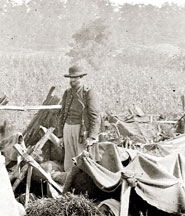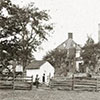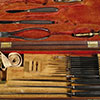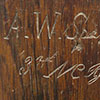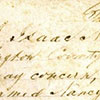|
- Christie Stanczak, Park Ranger, Antietam National Battlefield
- Middle School
- Four lessons: Lessons 1-3 -- one class period each; lesson 4 and the final project - 2 class periods each.
[Back to top]
|
- Antietam National Battlefield, Sharpsburg, MD
-
This lesson demonstrates how objects in the Antietam National Battlefield museum collection serve as primary sources for learning how the Battle of Antietam affected soldiers, local residents, and the nation. By examining similar objects in the classroom, students will also learn object analysis, active inquiry, observation, deduction and research skills.
This unit includes four lessons and final project with corresponding activities using Antietam National Battlefield collections. The lessons below can stand alone or be done in sequence:
- Warm-Up Activity: "Battle of Antietam" documentary
- Lesson 1: "Deliver Us From this Terrible War"
- Lesson 2: "One Vast Hospital"
- Lesson 3: "This is Not the Way We Bury Folks at Home"
- Lesson 4: "Thenceforward and Forever Free"
- Final Project: "Broken Hearts Cannot be Photographed"
-
- How did the Battle of Antietam and the subsequent issuance of the Emancipation Proclamation affect local civilians, soldiers and their families; and the nation?
[Back to top]
|
| MUSEUM OBJECT [photos of objects in the Carl Sandburg Home NHS museum collections] |
SIMILAR OBJECTS [local items similar to museum objects] & OTHER MATERIALS |
Length of time |
|
50-60 minutes |
|
- Paper and pencils/pens for students to write their own letter or diary entry.
- Smith's barn, used as a hospital after the battle of Antietam, Keedysville, Md., vicinity Alexander Gardner photograph, September 1862
- Straw huts erected on Smith's farm used as a hospital after the battle of Antietam Alexander Gardner photograph, September 1862, Keedysville, Maryland (vicinity).
- Confederate wounded at Smith's Barn, with Dr. Anson Hurd, 14th Indiana Volunteers, in attendance. Keedysville, Md., vicinity. Alexander Gardner photograph, September 1862,
- Clara Barton, Carte-de-Visite, ca. 1865 Photographic print on carte de visite mount. Library of Congress. LC-USZC4-6307
- One Vast Hospital letter/transcript
CLICK here to download all Lesson 2 Materials. |
50-60 minutes |
|
- Antietam, Maryland: A Lone Grave. Stereograph by Alexander Gardner.. September 1862 LC-B811- 570 [P&P] LOT 4168 (corresponding print)
- Soldier standing at graves of Federal Soldiers at Burnside Bridge at Antietam, Maryland. Photographic print. AndrewGardner September 1862,Library of Congress. LC-B815- 585 [P&P] LOT 4168
- Antietam, Maryland: Burying the dead Confederate Soldiers. Glass negative. Andrew Gardner, September 1862. Library of Congress. LC-DIG-cwpb-01098
- This is not how we bury folks at home” primary source handout
- Web site. Antietam National Cemetery National Park Service.
- Civil War blog. Wheeler, L. (2008, December 28)Union Soldier's Remains Found at Antietam. The Washington Post.
- How to Read an Object chart
- Recent student photograph brought from home.
- Keeping History: Cartes-de-Visite - the first pocket photographs. Georgen Gilliam Charnes. Nantucket Historical Association.
- Map of free, slave, and border states
- Written Document Analysis Worksheet
- Abraham Lincoln, seated and holding a book, with his son Tad (Thomas) leaning on a table. Feb 5, 1865.Alexander Gardner. Library of Congress. LC-USZ62-7990
- Frederick Douglass: A lecture on Our National Capital. 1876. Library of Congress
- Clara Barton: A wartime photograph by Brady. ca. 1890-1910. Library of Congress LC-USZ62-108565
- Camp of 31st Pennsylvania Infantry near Washington, D.C., 1862. Library of Congress Lot 4172-C, no. 5 [P&P]
CLICK here to download all Lesson 3 Materials.
|
Two class periods of 50 – 60 minute sessions each |
|
CLICK here to download all Lesson 4 Materials.
|
50 – 60 minutes |
[Back to top]
|
National Center for History in the Schools, United States History Content Standards for Grades 5 -12 http://www.nchs.ucla.edu/Standards/us-history-content-standards/us-era-5#section-2
» History/Social Studies » Grade 6-8, http://www.corestandards.org/ELA-Literacy/RH/6-8.
National Council of Teachers of English http://www.educationworld.com/standards/national/lang_arts/english/k_12.shtml
Consortium of National Arts Education Associations, National Standards for Arts Education, http://www.educationworld.com/standards/national/arts/visual_arts/5_8.shtml
|
Through object-based inquiry and hands-on students activities students will be able to communicate their ideas and hypotheses of the effect of the Battle of Antietam and the Civil War on local civilians, surviving soldiers and their families, and the country through analysis of museum objects, oral and written presentations, group activities and development of a Civil War exhibit.
[Back to top] |
See the attached PDF.
[Back to top] |
Cannonading: heavy fire of artillery (cannons).
Casualty: soldier who has been killed, wounded, captured, or declared missing in battle.
Civilian: person who is not a soldier.
Confederate: Southern soldier during the American Civil War.
Dunker: member of the German Baptist Brethren Christian denomination who practice full immersion
in water during baptism. They are pacifists (opposed to war, violence and military service).
Emancipation Proclamation: The document the President Lincoln issued on January 1, 1862 to end slavery in areas in rebellion against the Union. (Enslaved persons in Border States like Maryland were not freed by the Emancipation Proclamation).
Epitaph: Text or writing to honor the deceased person.
Manumission: setting free from slavery.
Stereoscope: an optical instrument that uses two images of an object to produce a single image of the object.
Re-inter: To re-bury something.
Union: Federal or northern side during the American Civil War.
CLICK HERE to download Vocabulary PDF.
[Back to top]
|
|
Certain images graphically portray dead soldier in the aftermath of battle. Please review them for appropriateness before showing them in the classroom. There are also discussions about death and dying in this lesson plan.
[Back to top] |
This unit includes four lessons and a final project involving the collections at the Antietam National Battlefield.
- Warm-Up Activity: Battle of Antietam documentary (6 minutes long).
- Lesson 1: “Deliver us from this Terrible War”
- Lesson 2: “One Vast Hospital”
- Lesson 3: “This is Not the Way We Bury Folks at Home”
- Lesson 4: “Thenceforward and Forever Free”
- Final Activity: “Broken Hearts Cannot be Photographed”
Students will use museum objects and other primary sources to understand some of the problems that the local farmers faced in the aftermath of the Battle of Antietam.
Skills: Analysis of primary sources, writing, discussion, role-playing.
Activity: Provide students with the “Background Information Sheet,” “Mumma Claim Record,” “Destroyed Mumma Farm," Alexander Gardner photo, and “James Hope Painting, ‘A Fateful Turn.’ (http://www.nps.gov/anti/photosmultimedia/Hope-Paintings.htm).” After students have studied the resources, show them the Museum Collection Item (photo of original letter), claim record, and photograph of Samuel and Elisabeth Mumma, and then have them read the text version of the James Clark letter (“Deliver us from this Terrible War” activity handout), Students will then imagine that they are Samuel Mumma, Jr. and divide into small groups to to write a response. Afterwards, students will read Mr. Mumma’s actual response to Sgt. Clark and compare and contrast their responses to the actual response.
Background Information:
Students will use a museum object and other primary sources to understand medical care in the aftermath of battle.
Skills: Analysis of primary sources, writing, discussion, role-playing, map-reading.
Activity:
- Students examine the surgeon’s kit in Antietam’s museum collection and complete the How to Read an Object worksheet. They compare and contrast similar items (modern first aid kit, Clara Barton’s first aid kit, and military trauma kit, and study historic photographs of the field hospitals).
- Students will then read diary entries, letters, and quotes from doctors, wounded soldiers and others who helped with medical care in the aftermath of battle.
- Students reflect on what they have read and assume the role of a doctor, soldier, or civilian involved in care of the wounded and write a journal entry about their experience, report to the commanding surgeon on hospital conditions or provide written instructions to a nurse for the short and long term care of the sick and wounded.
- Students develop a list of items that Clara Barton would have brought with her to the battlefield. Groups role play how she would have handled the immediate and after care of the wounded.
- Concluding activity: Students examine the cane, its manufacture and uses and then discuss what types of activities would occupy them as modern or Civil War soldier if they were recovering from a wound or illness. Students research advances in prosthetic limbs from the Civil War to modern time and report their findings.
Pvt. Roland Bowen, 15th Mass Infantry.
Skills: Reading, writing, drawing, analysis of primary sources.
Background Information
Activity: Students l analyze museum objects associated with burials on the field, historic photographs of some of the burial details, handout of soldiers buried in the Antietam National Cemetery, (link to pdf “These Honored Dead”, (link to pdf) photograph of National Cemetery headstones, and background information on the Antietam National Cemetery. Students will then complete the “How to Read a Museum Object” worksheet for the wooden headboard. Afterwards they will read the primary source handout (link to pdf “This is not how we bury folks at home” handout), and newspaper article. Student will use large format paper to draw and design their own private or military cemetery and corresponding headstones based on the following questions:
- Who is the cemetery for: Union soldiers, Confederate soldiers, soldiers from both sides or civilians?
- How have you identified people buried in your cemetery? What types of gravestone or markers do they have? Are there epitaphs? Are all of the markers different or the same? How are gravestones for unknown soldiers marked?
- How do you want to lay out your cemetery? Does it have a wall; are the graves chronological or alphabetical? What is your policy on recently discovered remains, where are they buried? Will the cemetery have any monuments or memorials or other commemorative objects? What type of landscaping does your cemetery have?
- What can you add to the cemetery to make it easy to find people buried there? What other types of things might be appreciated by cemetery visitors?
- Who will take care of the cemetery 100 years from now?
Students then serve on “committees” and listen to the cemetery designers give a “tour” of their cemetery. They will discuss the various pros and cons of the different cemetery plans. They will then vote on their favorite plan.
As a concluding activity, students will write a newspaper article on various issues such as locating graves, identifying soldiers, or the creation and dedication of a community war memorial.
Activity (two class periods):
Activity: Class Period 1-Students will examine Nancy Camel’s carte-de-visite and compare it to other historic photographs. Students will then complete a “How to Read a Photograph” worksheet and design their own carte-de-visit.
Skills: Reading, writing, utilizing primary sources, visual arts.
Activity: Nancy Camel carte-de-visite. Students: Complete the How to Read a Photograph chart on Nancy Camel’s photograph
- Read the article by Charnes,G. Keeping History Cartes-de-Visite - the first pocket photographs published by the Nantucket Historical Association.
- Study the selected historic photographs
- Make their own carte-de-visite and write a detailed caption. For a digital photograph, drawing, or painting use their own clothing and belongings that are personally meaningful. These will be included in the exhibit.
Class Period 2: Students will examine the Emancipation Proclamation and background information on Nancy Camel and Jerry Summers (link to pdf of “Lesson 4 background materials”) and work in small groups to complete “ Written Document Analysis” (link to webpage http://www.archives.gov/education/lessons/worksheets/written_document_analysis_worksheet.pdf)
worksheet on Nancy Camel’s manumission paper. Students will then “interview” Nancy (a free woman) and Jerry (who would have still been enslaved after the Emancipation Proclamation was issued because he lived in the border state of Maryland), and write a newspaper article that covers how each responded to the social, financial, and personal ramifications of slavery and this granting of freedom.
Skills: Reading, writing, using primary sources, working together in small groups.
Museum Objects: Manumission paper of Nancy Camel.
Similar Items:
- Text copy of Manumission paper
- Copy of the Emancipation Proclamation,
- Map of free, slave, and Border States.
Background Information Text
Skills: Research, creative presentation of work, small group work, writing, oral presentation, drawing, photography, painting.
Background Information for Activity: Alexander Gardner at Antietam
Activity: Students will reproduce Civil War photographer Mathew Brady’s New York Studio. Each student will produce one “photograph” or item that tells something about real or imagined person (soldiers or civilian), place, or story from the Battle of Antietam or its aftermath. These can be black and white drawings, charcoal drawings, gray-scale water color pictures, or black and white photograph where the students recreate a famous portrait or picture from the era. Students develop captions and an accompanying exhibit catalog for these items and the carte-de-visites made earlier and create an exhibit in the classroom or hallway or. Each student prepares a ‘docent tour’for the exhibit.
|
- Journal entry
- Letter writing activity
- Completed “How to Read an Object” and “How to Read a Photograph” worksheets
- Final project and oral report about project
- Class participation
[Back to top]
|
- If the class can visit the park, complete:
-“Antietam National Cemetery Exploration” activity, (pdf, 8 mb).
-“Mumma Cemetery Exploration” activity, (pdf, 763 kb, 4 pages).
- Have students bring in a photograph of themselves or a family member. Have them compare the completed “How to Read a Photograph” Worksheet” for Nancy Camel’s photograph to a worksheet they complete on their own photo.
|
Antietam Bibliography for Teachers
Antietam Bibliography for Students
[Back to top]
|
Pre-visit: Before the actual or virtual visit, have students visit the park’s website for an overview. Have each student come up with 2-3 questions to guide the visit.
On-Site visit: The park provides ranger-led, curriculum-based education programs that can be reserved in advance. Antietam National Battlefield, 5831 Dunker Church Rd., Sharpsburg, MD 21782. Contact: http://www.nps.gov/anti/forteachers/planafieldtrip.htm.
Students can complete the Museum Scavenger Hunt.
Click here for the answer sheet.
Virtual Site Visits:
[Back to top] |
|

